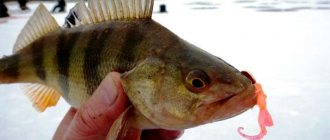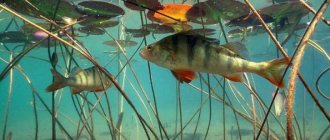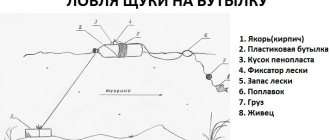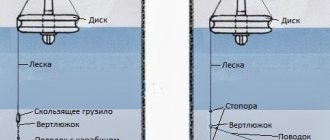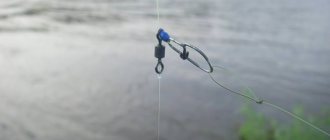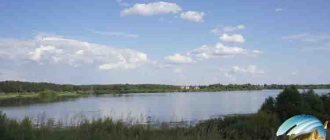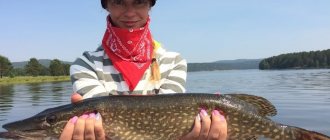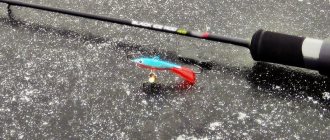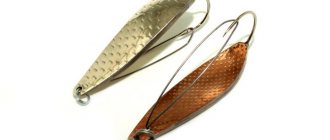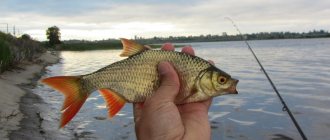Pike in December
Pike continues to actively feed in winter, and its behavior depends on the climatic conditions of the region and the characteristics of the reservoir. Small lakes, small rivers, channels and river bays are covered with ice. At the beginning of the calendar winter on large and medium-sized rivers, a safe thickness of ice for fishing forms in the coastal zone.
In December, pike wait for prey in coastal depressions or in thickets of reeds (reeds, cattails). Only a complete lack of food forces the predator to move to another area. The main prey for pike in December are small peaceful fish that have not had time to burrow into the silt and are in a lethargic state.
In the first winter month there are still relatively warm days, during which the activity of the predator increases. A good bite is also observed on cloudy days at temperatures from 0 to 5 degrees. Such conditions are typical for the central and southern regions. When fishing on the first ice, the likelihood of catching a trophy pike increases.
Tackle components
Gone are the days when pike could be caught on a “stick” with a primitive spoon. And the size of prey has now become smaller, and the fish itself has become smarter and more cunning. Therefore, it is advisable to use elegant and sensitive gear for ice fishing. Moreover, modern fishing rods, fishing lines, and lures have become more reliable and durable.
Rod
For winter pike fishing with lures, a long rod is required.
This is explained by the fact that when searching for pike you need to constantly look for changes in depth. It’s convenient to do this with a long fishing rod, then when moving from hole to hole you won’t have to wind or unwind the fishing line on the reel. determine the depth by moving the rod vertically. In addition, the rod must be strong enough, because when fishing, a large pike can break not only the whip, but also the rod itself. An example of a good fishing rod is the Finnish model Delfin E 90, which is equipped with a 35 cm long fiberglass whip and a 12 cm long neoprene handle.
Coil
For ice fishing for pike, the rod must be equipped with an external reel with a diameter of 8-10 cm. The presence of a ratchet brake will help cope with jerking fish, dropping the line if necessary.
fishing line
The main requirements for the fishing line will be:
- strength;
- low stretchability;
- rigidity.
When fishing for pike during a thaw, you can successfully use a braided line, but in frosty weather there is no alternative to monofilament. The thickness of the fishing line is selected according to the intended catch; usually it is enough to wind up to 50 m of 0.3-0.4 mm fishing line on a reel.
Pike in January
In the middle of winter, most small fish that do not hibernate (perch, roach, rudd, etc.) concentrate in holes and become the main prey of the toothy predator. In January, pike need less food, but do not stop feeding. Sedentary small fish caught in the field of view of a pike are potential prey.
In small bodies of water with stagnant or low-flow water, pike can be found throughout the water area. In rivers, the predator enters deep areas away from the channel flow and river rapids.
Three phases of pike fishing in winter
Pike in winter are no less active during the period of open water, and under some circumstances even show gluttony much higher than in summer. Freezing does not scare the fish, but rather stimulates it to feed more. In addition, the victims of the toothy one are not as nimble as in flight and more easily become accessible objects of its hunt. Over time, only the lack of oxygen in the reservoir affects the activity of the pike, making its behavior passive, and its feeding irregular and weak.
Knowing the phases of predator behavior that depend on weather conditions during the winter season, experienced fishermen quite accurately predict the activation of the bite or its absence, making only successful trips to the reservoir. Combined with knowledge of the capabilities of certain gear, selected according to the time of hunting, pike are rarely left in winter without the coveted trophy. The three phases of catching toothfish will be the continuation of our article.
Read what the optimal pressure should be for pike fishing in winter.
Fishing for pike in early winter
Biting intensity in early winter
Early winter is considered a promising period for winter pike fishing. First ice is characterized by stable bite and increased aggressiveness of the predator. This is caused by a change in the regime in the reservoir, which, after being covered with ice, becomes quiet and without mixing the waters by the wind. They are also highly saturated with oxygen.
The small fish have not yet completely retreated to the depths, and the predator stays in shallow waters, hunting for small fish in the dead, dying algae. First ice, and this phase lasts about 7–10 days after the reservoir is covered with ice, the highest levels of fishing occur. Many pike fishermen spend a whole year preparing for pike fishing on the first ice, considering it the peak of the entire annual season.
Be careful when entering the first ice. The ice thickness must be at least 10 centimeters. You must have life preservers with ropes with you.
After the second week of freeze-up, the intensity of the bites decreases, turning into the so-called exit bite, increasing at certain times of the day. Short thaws stimulate biting. A sharp increase in ice followed by frequent snowfalls, on the contrary, reduces the activity of the toothed fish, shifting its hunting zones to deep areas of reservoirs.
Cloudy weather with a moderate south or south-west wind is one of the most favorable signs of a confident and stable pike bite at the beginning of winter.
Glukhozimye
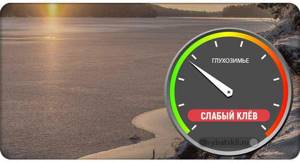
Biting in the wilderness
Midwinter is a depressive fishing season. Now you can find pike on the edges of holes in stagnant bodies of water or on the edges of fast streams in rivers where the waters are saturated with oxygen. The wilderness coincides with the calendar beginning of January. Fish move from the shallows to the depths due to the massive onset of decay of fallen algae, as a result of which the water deteriorates, in other words, it becomes rotten. In closed shallow reservoirs, this phenomenon becomes the main cause of death. Oxygen starvation makes the toothy one passive. Pike feed rarely in January, preferring medium-sized live bait.
There is no movement of fish through the reservoir and the fisherman will have to look for a place where the fish are staying. On frequently visited reservoirs, remember the pike catching points and constantly fish such places. Often the caught trophy will be covered with leeches, which confirms the fish’s apathy towards intensive searches for food.
Biting activity increases during periods of prolonged thaws with clear weather and moderate winds. Snowfalls and severe frosts in the dead of winter reduce the likelihood of biting.
End of winter
The end of winter is characterized by frequent, prolonged thaws with ice moving away from the shores and thawed patches appearing in areas where vegetation emerges from the water. The influx of fresh water increases its oxygen saturation, which in turn activates all types of fish, including pike. In addition, the approaching spawning period stimulates the predator to increase feeding. Now the frequency of bites increases, and the fish’s grip becomes more reliable. Disappearances and idle bites at the end of the freeze-up are observed less frequently. The fish comes out to the thawed areas, where they try to catch them.
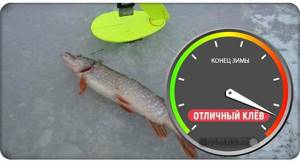
Biting intensity at the end of winter
Sunny and windless days with positive temperatures are characterized by a good bite.
One of the tricks of fishing during this phase is the use of smaller live baits. The belly of pikes is filled with caviar and the fish tries to hunt relatively small-sized prey, which is radically different during periods of fresh ice, when the use of large baits is justified. The last ice promises the capture of trophies, the so-called mothers, fattening before the spawn. Therefore, records for the catch of large pike are typical for this period of the year.
Pike in February
As a result of prolonged freeze-up, the oxygen saturation of water decreases. In February, pike shift to areas with natural springs, enter river mouths, and can also concentrate in shallow water in coastal thickets.
In February, the pike moves little around the water area of the reservoir, and ambushes behind bottom obstacles: snags, fallen or flooded trees, etc. The predator becomes active with the beginning of ice melting, but this process begins only with the arrival of calendar spring. In such conditions, promising pike fishing on the last ice becomes possible.
Last ice and pike spawning
At the end of winter, deep-sea pike leave deep-sea anchorages and go to shallow waters. This is partly due to a better oxygen regime and, as a consequence, a better food supply, but the main reason is still the shift of the predator to the spawning grounds.
Pike spawns in wetlands, bays, mouth areas of tributaries, spills and other shallow waters. Spawning begins under the ice or immediately after the ice melts, so the increased feeding activity of pike “on the last ice” is nothing more than a pre-spawning glutton.
One of the promising places where pike fishing will be successful throughout the winter is a dump near the border of reed thickets.
On such a dump there is a significant difference in depth and, accordingly, in living conditions. Therefore, the pike will feed on it throughout the winter, making short trips from the depths of the shallows and vice versa.
Where to look for pike in winter
It’s easier to find pike in winter on small rivers, lakes and flooded quarries. In a confined space, her movements are limited. On large and medium-sized rivers, searching for predators becomes more difficult. You should pay attention to the typical signs of promising areas for catching pike from ice:
- Depressions in the coastal strip with lush vegetation. In such places, pike are caught more often, regardless of the natural characteristics of the reservoir;
- Islands of vegetation sticking out from the ice;
- Pits in flowing river bays;
- Mouths of tributaries;
- Ducts;
- Areas with bottom obstacles;
- Lower eyebrows;
- Bottom springs;
- Areas located near the outlets of “waste” water in industries;
- Places near existing gullies. It is important here to control the thickness of the ice when moving.
Winter lures for pike
To catch predators from ice, all artificial baits designed for vertical fishing are suitable. Popular winter lures for pike:
- Oscillating spoons;
- Rattlins;
- Fishing balancers;
- Jig baits: twisters, vibrotails and foam fish.
How to choose lures for pike
There are no special pike baits. It is useful to know how to choose lures for pike that most effectively provoke the predator to bite. For targeted fishing, you should not choose small models, the length of which does not exceed 5 cm. But it will not be possible to completely exclude the passing bite of other predatory fish. Large baits can catch perch, ide, etc.
It is important to choose baits that well imitate the behavior of a wounded fish. Achieved by skillful play when flashing.
The color of the bait plays a secondary role. On cloudy days it is better to use models with bright colors, and on sunny days – matte colors. Spoons whose sides are painted in contrasting colors work well. They are suitable for catching pike in winter in all weather conditions.
Fishing for pike on girders
Catching pike using girders, baits or donks is characterized by high efficiency. These gears “work” on the same principle. The postavushka differs from the winter zherlitsa in the absence of a bite alarm. A simple donk is a reel with appropriate equipment. These gears are designed for self-hooking of predatory fish.
Rigging for pike
The classic winter fishing rod is a base with an attached reel, equipped with a line lock and a flag (bite alarm). This is a universal tackle that can be used for pike fishing during the day, and at dusk - for stationary fishing for burbot.
The rigging of a pike rig is made for specific fishing conditions. It is necessary to take into account the depth and speed of the current. Installation of the equipment for a winter girder, set-up or donkey can be done in different versions: with or without a sinker, with a metal or nylon leash.
The sequence of installation of the girder equipment for pike in winter:
- A long fishing line is tied to the reel or reel of the donkey based on the following calculation: maximum fishing depth + 15-20 m. The best option is a high-quality fishing line with a diameter of 0.2 mm.
- A sinker is tied to the free end of the fishing line, designed to hold the bait near the surface of the bottom. Leash length – 0.5-1.5 m.
Fishing for pike from ice using a spoon
Of course, avid spinners do not count on the crazy bite that was observed during the first ice in the middle of winter. Nevertheless, many of them manage to achieve good results even in these difficult times for fishing. When catching pike with a spoon from ice, the only effective tactic is constant active search. In a promising area of the reservoir, many holes are drilled at once, and then they are fished in turn, staying at each for no longer than 2-3 minutes. This is approximately 10-15 strokes of the fishing rod. If a predator is standing under a hole, it will definitely respond to the first few bait throws.
The technique differs significantly from fishing on the first or last ice. In January-February, sluggish pike are reluctant to react to fast play, so swings of the rod should be smooth, with long pauses at the bottom point (6-7 seconds). Another working animation option is light twitching of the rod, during which the spoon rises up 15-20 cm and no more. If there are no bites, you should try to diversify the game, introduce some new elements into it, for example, just move the bait slightly. Thanks to experiments, even with a seemingly absolute lack of bite, sometimes it is possible to feel that very long-awaited blow transmitted to the hand.
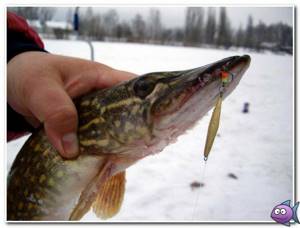
As for spinners, from all their variety it is difficult to single out models that show high efficiency always and everywhere. Situations often occur when local fishermen catch more with cheap summer spoons than visiting professionals with expensive branded baits designed for winter lures. That is why it is not worth betting on any specific type of spinners. It would be more correct to have a dozen or two different models in your arsenal and select a working one from them during the fishing process. The main thing is that in appearance they resemble a fry that lives in a reservoir, and therefore is familiar to pike.
Catching pike with a winter fishing rod
Active pike fishing in winter is carried out with a winter fishing rod using artificial baits. Pike does not miss the opportunity to capture bait, which in appearance and behavior reminds it of potential prey. Fishing for pike with a winter fishing rod can be effective during the freeze-up period.
Winter fishing rod rig for pike
Budget winter fishing rods 30-40 cm long are suitable for catching pike from ice. A simple inertial reel is suitable. It can be built into the rod or additionally secured using special devices.
Requirements for a winter fishing rod for pike:
- The rigidity of the whip should ensure timely hooking of a pecked predator;
- Mobility: quick assembly of tackle the next time you move to another hole;
- Metal leash.
Technique for catching pike with a winter fishing rod
At least 10 holes are drilled over a promising area for pike fishing. When actively searching for pike in winter, you should not linger on fishing one hole for more than 5 minutes. During this time, different wiring is used using existing baits.
It is important to consider that pike in winter do not attack bait without first studying it. The keen vision of a predator allows it to notice the unnatural behavior of potential prey.
It is advisable to practice wiring to achieve the desired action of the bait before going on targeted winter fishing for pike at home.
It should be noted that with a successful choice of place for fishing, proper preparation of gear and bait, pike fishing in winter will bring a lot of positive emotions.
How to catch pike in winter
Ice fishing in winter is not an easy task. It requires a certain dexterity and skill in catching a predator. Pike is a very strong fish and offers great resistance when fishing. Therefore, the gear for it must be strong and reliable.
Zherlitsy
Classic girders are the most popular types of pike fishing with live bait in winter. The pole consists of a wooden pole, a stand, a coil and a spring on which a flag is attached. It is equipped with a tackle made of strong fishing line, a tungsten leash and a metal hook on which live bait is attached.
Catching pike on girders in winter has its own characteristics. To do this, holes are pre-drilled in the reservoir, the distance between which should be from 4 to 6 meters. The depth of the bait must be measured in advance, and then put the fry on the hook and reel the reel back to raise the bait above the bottom.
The girder stand must be installed on the ice, and the hole must be covered with snow for camouflage. After the pike bites, the line begins to unwind from the reel. As a result, the flag straightens and signals the start of the bite. The fish must be hooked sharply and rapidly during its jerks, until it is completely exhausted, gradually pulling it towards the hole.
Winter lures (spinners, balancers)
Spinner is considered one of the main baits for pike in winter. Of course, it shows the greatest effectiveness at the beginning of the season, when the fish are quite active. Before going fishing, it is better to stock up on as many models of this bait as possible, choosing the right one during the fishing process. If the weather is clear, it is better to use bright lures; in cloudy weather, dull lures are preferable.
The most effective way of fishing with an oscillating spoon is a smooth retrieve with pauses. First you need to drill several holes at a distance of 4-6 meters. Then the spoon is lowered to the bottom, and then raised by 30-50 cm, pause for 4-6 seconds and then lower the bait again. Such actions are performed several times and move on to the next hole.
Although the pike is inactive at this time, if it is caught, the situation must be kept under control, absorbing the shocks of the predator. Gradually releasing the fishing line, the pike needs to be brought to the hole and fished out using a hook.
Fishing with a balance beam is considered a rather interesting and effective way. Unlike a spoon, it is positioned horizontally in the water, and the hooks are attached to the head and tail of the bait.
This type of fishing is similar to the game of spinners, with the exception of some differences.
- You need to drill more holes, about 10 pcs.
- You need to start fishing from the first and move in order to the last.
- The balancer must be lowered into the water, but not reach the bottom.
- Then the bait must be thrown 20-25 cm up and returned to its original position.
- After a pause and no bite, the actions are repeated.
Video: Fishing in winter from ice on a balance beam
Ice fishing for pike in winter using rattlins
This method is considered one of the most interesting. In winter, silent rattlins are more often used. When fishing this way, movements should also be smooth and unhurried. The optimal size of the bait is 7 cm, the color is silver, but at greater depths it is better to use bright colors. With classic winter fishing, the bait must first be lowered closer to the bottom, then the rod should be smoothly raised by 15-20 cm and lowered again, achieving an even play of the rattlin. This kind of fishing is suitable even for beginners, since rattlin’s game can attract even a passive predator.
About
